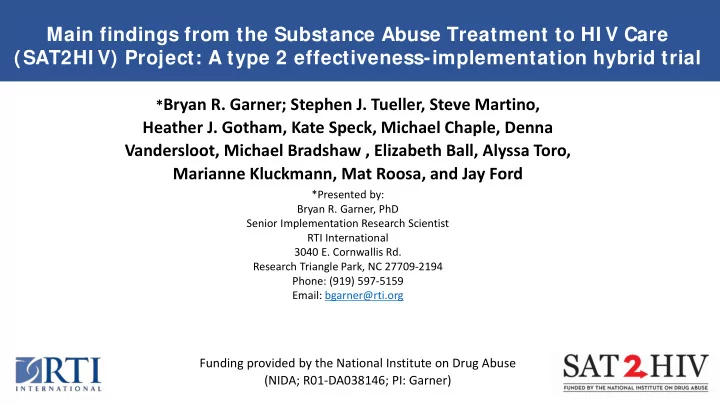

Main findings from the Substance Abuse Treatment to HI V Care (SAT2HI V) Project: A type 2 effectiveness-implementation hybrid trial * Bryan R. Garner; Stephen J. Tueller, Steve Martino, Heather J. Gotham, Kate Speck, Michael Chaple, Denna Vandersloot, Michael Bradshaw , Elizabeth Ball, Alyssa Toro, Marianne Kluckmann, Mat Roosa, and Jay Ford *Presented by: Bryan R. Garner, PhD Senior Implementation Research Scientist RTI International 3040 E. Cornwallis Rd. Research Triangle Park, NC 27709-2194 Phone: (919) 597-5159 Email: bgarner@rti.org Funding provided by the National Institute on Drug Abuse (NIDA; R01-DA038146; PI: Garner)
The Problem: I ntegrating HI V services with other health services “In summary, given the existing evidence that largely supports HIV integration from a public health and clinical perspective, the findings of this review support further efforts to integrate. However, significant evidence gaps remain. Unfortunately, few of the studies found adequately address the central questions currently concerning many programme managers at this moment in time: not whether to integrate, but when to, how to, and which model is most efficient in which setting?”
The Setting: Community-based AI DS Service Organizations (ASOs) Substance use can negatively impact ASOs ability to achieve goals of the HIV Care Continuum Substance Use Integration of Motivational Interviewing-based brief intervention for substance use
The Substance Abuse Treatment to HI V Care (SAT2HI V) Project: A doubly r random ized type 2 effectiveness-implementation hybrid trial Garner, B. R., Gotham, H. J., Tueller, S. J., Ball, E. L., Kaiser, D., Stilen, P., Garner, B. R., Zehner, M., Roosa, M. R., Martino, S., Gotham, H. J., Ball, E. L., ... Martino, S. (2018). Testing the effectiveness of a motivational ... Ford, J. H. (2017). Testing the implementation and sustainment interviewing-based brief intervention for substance use as an adjunct facilitation (ISF) strategy as an effective adjunct to the Addiction Technology to usual care in community-based AIDS service organizations: study Transfer Center (ATTC) strategy: Study protocol for a cluster randomized protocol for a multisite randomized controlled trial. Addiction Science & trial. Addiction Science & Clinical Practice, 12(1), 32. Clinical Practice, 13 , 9.
The Method: A doubly randomized 39-site type 2 effectiveness-implementation hybrid trial The ISF Experiment The MIBI Experiment
The Method: A doubly randomized 39-site type 2 effectiveness-implementation hybrid trial The ISF Experiment The MIBI Experiment
Staff-level Proficiency (Miller et al., 2004; Martino et al. 2008) Proficiency demonstrated when “at least half of the MI-consistent items rated average or above in terms of adherence and competence.” Martino et al., 2008
Staff-level I mplementation Effectiveness (Klein & Sorra, 1996; Klein, Conn, & Sorra, 2001) “Implementation effectiveness refers to the consistency and quality of targeted organizational members’ use of a specific innovation.” Klein & Sorra, 1996
Staff-level of Sustainment (Aarons et al., 2011; Hunter et al., 2014) “use the term sustainment to denote the continued use of an innovation in practice.” Aarons et al. 2011
The Method: Participant Flow
The Method: Participant Flow
The Method: Participant Flow
The Method: I mplementation Conditions 1. Name it 2. Define it 3. Specify it a) The Actor b) The Action c) Action Target d) Temporality e) Dose f) Implementation Outcome g) Justification
The Method: Addiction Technology Transfer Center (ATTC) implementation strategy A. Centralized technical assistance B. Develop educational materials C. Develop and organize quality monitoring systems D. Develop tools for quality monitoring E. Distribute educational materials F. Conduct educational meetings G. Make training dynamic H. Audit & Provide feedback I. Provide ongoing consultation J. Create a learning collaborative
The Method: I mplementation & Sustainment Facilitation K. Use an improvement and implementation advisor L. Develop tools for quality improvement M. Organize implementation team meetings N. Identify and prepare champions O. Assess for readiness and identify barriers P. Conduct local consensus discussions Q. Conduct cyclical small tests of change
The Method: Addiction Technology Transfer Center (ATTC) implementation strategy
The Method: Addiction Technology Transfer Center (ATTC) implementation strategy
Strategy dose during preparation phase
Strategy dose during implementation phase
Strategy dose during sustainment phase
The Substance Abuse Treatment to HI V Care (SAT2HI V) Project: A doubly r random ized type 2 effectiveness-implementation hybrid trial Garner, B. R., Gotham, H. J., Tueller, S. J., Ball, E. L., Kaiser, D., Stilen, P., Garner, B. R., Zehner, M., Roosa, M. R., Martino, S., Gotham, H. J., Ball, E. L., ... Martino, S. (2018). Correction to: Testing the effectiveness of a ... Ford, J. H. (2017). Testing the implementation and sustainment motivational interviewing-based brief intervention for substance use as facilitation (ISF) strategy as an effective adjunct to the Addiction Technology an adjunct to usual care in community-based AIDS service Transfer Center (ATTC) strategy: Study protocol for a cluster randomized organizations: study protocol for a multisite randomized controlled trial. Addiction Science & Clinical Practice, 12(1), 32. trial. Addiction Science & Clinical Practice, 13 , 9.
Results: Main Findings Organizational-level assignment to ISF condition OR = 1.92** OR = 0.98 Staff-level Staff-level Implementation Proficiency Effectiveness OR = 0.11* Client-level Client-level assignment to Substance Use UC+MIBI condition * p < .05; ** p < .01
Discussion: Key Takeaways, Lessons Learned, and Next Steps
Discussion: Key Takeaways 39 Distinct ASOs
Discussion: Key Takeaways 39 Distinct ASOs 39 Distinct ASOs (100%)
Discussion: Key Takeaways 39 Distinct ASOs 34 Distinct ASOs 39 Distinct ASOs (87%) (100%)
Discussion: Key Takeaways Organizational-level assignment to ISF condition OR = 1.92** ISF had a significant impact on Staff-level an implementation outcome Implementation Effectiveness ISF had a significant impact on a client outcome OR = 0.11* Client-level Client-level assignment to Substance Use UC+MIBI condition * p < .05; ** p < .01
Discussion: Lessons Learned Type 2 effectiveness-implementation hybrid trials are not for the faint of heart
Discussion: Lessons Learned Type 2 effectiveness-implementation hybrid trials are possible… with the right infrastructure and team
Discussion: Lessons Learned Practice Common Goal Research
Discussion: Next Steps iNod Other grants testing the ISF strategy
Recommend
More recommend